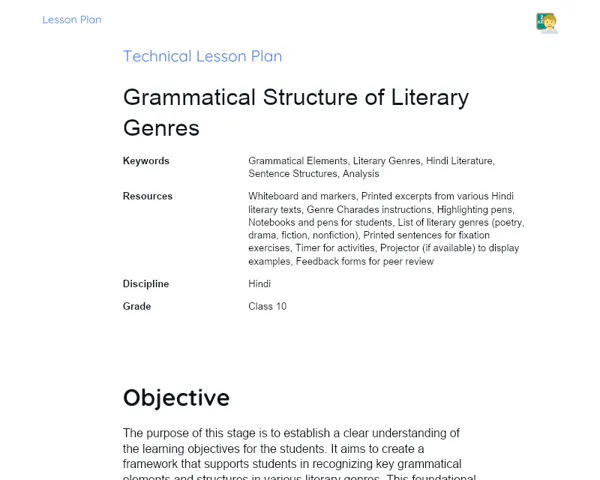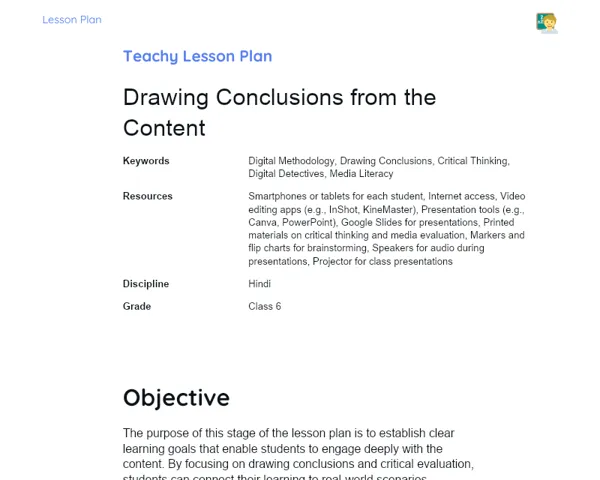Lesson Plan | Teachy's Iteractive Lesson Plan | Expression in Home and School
| Keywords | Expression, Home, School, Verbal Communication, Non-verbal Communication, Digital Storytelling, Social Media, Emojis, Active Listening, Peer Feedback, Cultural Contexts, Engagement, Creative Learning |
| Resources | Smartphones or tablets, Internet access, Digital storytelling apps (e.g., Canva, Storybird), Class social media platform (for sharing posts), Online quiz platforms (e.g., Kahoot, Quizizz), Art supplies (paper, markers, etc., for brainstorming), Projector or screen for presentations, Writing materials (notebooks, pens) |
| Codes | - |
| Grade | Class 1 |
| Discipline | Hindi |
Objectives
Duration: 10 - 15 minutes
The purpose of this stage is to establish a foundational understanding of how expressions differ in the home and school environments, enabling students to articulate their feelings and thoughts appropriately in various contexts. By focusing on both verbal and non-verbal forms of communication, students will learn to connect these expressions to their everyday lives, fostering a sense of belonging and the ability to engage meaningfully with their peers and families.
Main Objectives:
1. To identify and describe different modes of expression used at home and in school.
2. To enhance verbal communication skills by encouraging students to express their thoughts and feelings effectively.
Secondary Objectives:
- To develop active listening skills by engaging with peers' expressions and interpretations.
Introduction
Duration: 10 - 15 minutes
The purpose of this stage is to ignite curiosity and engagement among the students about the topic of expression in different environments. By using their devices to search for facts, they become active participants right from the start. This warm-up not only serves to refresh their prior knowledge but also paves the way for deeper discussions, allowing students to share personal experiences and connect the lesson to their daily lives.
Warming Up
To kick off the lesson, initiate a lively discussion about how we express ourselves differently at home and school. Ask the students to pull out their smartphones and conduct a quick search on ‘interesting facts about modes of expression’. Encourage them to find examples from their daily lives, whether it's through gestures, words, or even art. This not only sets the stage for the lesson but also integrates technology into their learning, making it relevant and engaging.
Initial Thoughts
1. What are some ways you express your feelings at home?
2. How do these expressions change when you are at school?
3. Can you think of a time when someone misunderstood what you meant? What happened?
4. What are some non-verbal ways we communicate with our family and friends?
5. Why is it important to express ourselves clearly both at home and in school?
Development
Duration: 70 - 85 minutes
The purpose of this stage is to immerse students in a creative and engaging activity that enhances their understanding of expression in different environments. By utilizing digital tools and platforms, students will explore various modes of expression, collaborate with peers, and apply their knowledge in practical, relatable ways. This approach not only solidifies their learning but also fosters creativity and communication skills.
Activity Suggestions
Activity Recommendations
Activity 1 - Digital Storytellers: Express Yourself!
> Duration: 60 - 70 minutes
- Goal: To encourage students to explore and articulate the ways expressions differ in home and school settings through a creative digital storytelling approach.
- Activity Description: In this activity, students will work in groups to create a digital story that showcases different modes of expression at home and school. Using storytelling apps or platforms like Canva or Storybird, they will illustrate characters expressing their feelings through dialogue and visuals. Each group will choose a scenario that represents a mix of both environments—home and school—and depict how expressions change based on the setting. They will also incorporate sound effects and voiceovers to enhance the storytelling experience. To present their stories, groups will record a video of their final product and share it with the class during the presentation phase.
- Instructions:
-
- Form groups of up to 5 students.
-
- Choose a scenario that highlights a different mode of expression at home and school. Possible scenarios include a celebration at home versus a class presentation, or a disagreement with a friend at school and a conversation with a family member.
-
- Plan the story's outline focusing on how expressions might differ in these contexts.
-
- Use a digital storytelling app to create visuals, add dialogue, sound effects, and voiceovers.
-
- Record a video of your storytelling to share with classmates.
-
- Present your story during the final segment of the class.
Activity 2 - Social Media Expressions Challenge
> Duration: 60 - 70 minutes
- Goal: To enable students to express their emotions digitally, understand context-specific expressions, and develop skills in digital communication and interaction.
- Activity Description: In this engaging activity, students will become digital influencers for a day! They will create an Instagram-style post and caption that represents an emotion or expression relevant to their experiences at home and school. Students will use their smartphones to take or find creative images that capture their chosen emotion. They will then craft a concise and engaging caption that reflects their expression and the context in which they feel it. Following this, each student will share their posts on a class social media platform created for this activity. They will also comment on at least two posts from their peers, practicing both expressing and interpreting emotions in a digital space.
- Instructions:
-
- Think about an emotion you have experienced at home or school recently.
-
- Use your smartphone to take a photo or find an image online that represents that emotion.
-
- Create an Instagram-style post including a catchy caption that explains the context of your expression.
-
- Share your post on the designated class social media platform.
-
- Engage with your classmates by commenting on their posts, noting how expressions may vary.
Activity 3 - Gamified Expressions: The Emoji Challenge
> Duration: 60 - 70 minutes
- Goal: To make learning about expressions interactive and engaging while developing students' understanding of emotions in diverse contexts.
- Activity Description: This activity turns learning about expressions into a fun, gamified challenge! Students will use an online platform like Kahoot or Quizizz to create and respond to a quiz that includes various expressions depicted through emojis. In groups, students will design questions that present scenarios using emojis to represent feelings and modes of expression—like a smiley face for happiness or a thinking face for confusion. After crafting their quizzes, groups will take turns answering each other's questions while discussing the different expressions represented and their importance in various contexts.
- Instructions:
-
- Form groups and choose a mix of emojis to represent different modes of expression.
-
- Create quiz questions on a platform like Kahoot or Quizizz that ask classmates to interpret the emoji scenarios.
-
- Share the quiz with the class and take turns answering questions.
-
- Discuss how the emojis used relate to real-life expressions at home and school.
Feedback
Duration: 15 - 20 minutes
The purpose of this stage is to consolidate learning by providing students with an opportunity to reflect on their experiences and share insights gained from the activities. Through group discussions and peer feedback, students will evaluate their understanding of expressions in home and school contexts, fostering collaborative learning and critical thinking. This reflective process encourages students to articulate their thoughts while developing their communication skills further.
Group Discussion
"Now that we've had an exciting time exploring expression through our activities, I invite all groups to share their stories with the class. What modes of expression did you highlight in your digital stories? How did you decide which expressions to use based on the home and school settings? Let's reflect together on what we've learned about communication in these environments."
Reflections
1. What was the most surprising thing you learned about expressions at home or school? 2. How did your understanding of expression change after participating in this lesson? 3. Can you identify a moment when your expression was misunderstood? How could it have been communicated differently?
360º Feedback
"As we wrap our activities, let's take a moment for feedback. Each of you will give constructive and respectful feedback to your group members. Consider what you liked about their work and suggest one improvement. Remember, the goal is to help each other grow and learn!"
Conclusion
Duration: 10 - 15 minutes
The purpose of this conclusion stage is to encapsulate the learnings from the lesson, helping students consolidate their understanding of expression in varied environments. By linking their experiences back to the real world, students can appreciate the relevance of what they've learned, encouraging them to continue exploring their communication skills in everyday situations. This reflective phase empowers students to recognize the importance of their expressions and equips them for future interactions. 🎓🔗
Summary
🌟 In today’s vibrant journey of 'Expression in Home and School', students dove into the captivating world of communication! They explored how we express ourselves at home with our families, maybe sharing a birthday cake and a loud ‘Happy Birthday!’ with joy and laughter, and contrasted it with the softer, more respectful tones during discussions with teachers in class. 🏠✨ Every group created digital stories that painted these expressions visually, while emojis brought fun to our discussions, revealing the language of feelings that transcends words! 🎉💬
World
In our hyper-connected world, modes of expression are evolving rapidly, especially with social media platforms being ingrained in everyday life. Students now communicate not just through words but also through images, memes, and emojis, making their understanding of expression more relevant than ever. This lesson highlights the significance of adapting our expressions to fit different settings—a crucial skill in our diverse society. 🌍💻
Applications
Understanding how to express oneself clearly is crucial in daily life, whether one is engaging with friends, family, or teachers. The skills developed through this lesson are applicable not only in academic settings but also in personal interactions and future professional environments. Clear communication fosters better relationships and avoids misunderstandings, paving the way for collaboration and harmony in both personal and communal spaces. 💖📚



